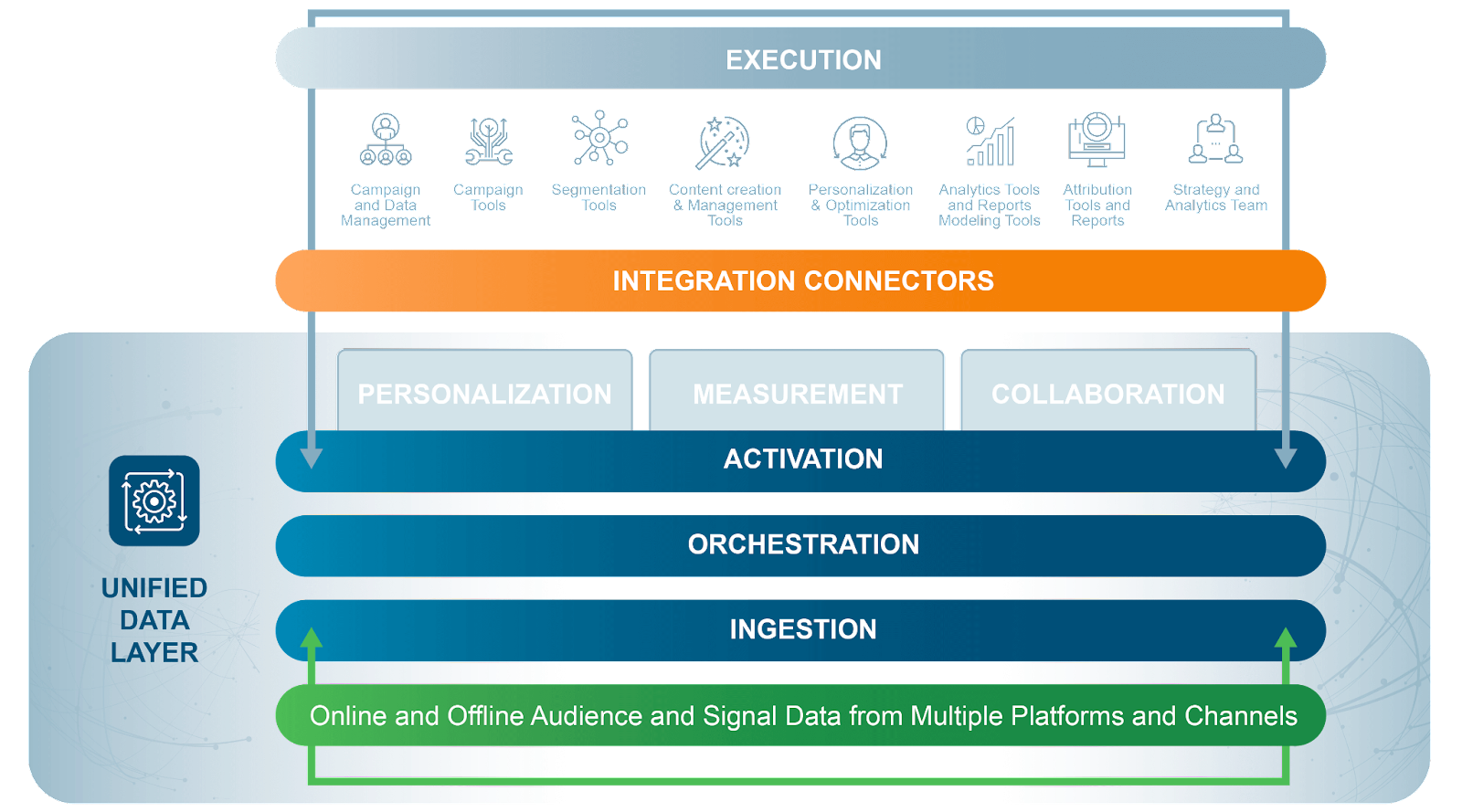Unified data
The keystone of relevant, personalized customer experiences is unified data
What is Unified Data?
A unified data model brings together all available information – each data point from each data source relating to an individual customer – into a single, accurate, consistent, 360-degree view. But successfully constructing this type of unified data architecture from disparate sources is a significant challenge.
The unified data challenge
Everyday, people use multiple devices to access and interact with digital content across multiple channels. For work, for pleasure (and all points in between), on mobile, tablet, or desktop, they manage much of their lives across online, social, cloud, and even virtual reality environments.
Each engagement is a touchpoint, a node in the complex network that describes peoples’ tastes, habits, preferences, purchases, pastimes, budgets, and biographies. It’s a vast amount of data. It’s big data.
From a brand perspective, bringing all these touchpoints together to achieve unified data has various complications, including:
- The inconsistencies and silos in which data is stored, processed, and updated within organizations.
- Aligning all first-, second-, and third-party data in a secure and privacy conscious manner in line with common data standards and legislation.
Despite its challenges, data unification delivers extraordinary benefits for both businesses and their customers.
| Data jargon buster: |
| First-party (1P) data: Data collected directly by a company about its own customers’ interactions and transactions on its platforms and services. |
| Second-party (2P) data: Data that is ethically and legally shared between two companies, often under a partnership agreement, for their mutual benefit. |
| Third-party (3P) data: Data about consumers ethically sourced from data brokers, advertisers, or other external third parties that have no direct relationship with the consumers. |
Why does unified data matter to you?
Creating a unified customer view is important to any business looking to deliver experiences that will help them acquire, retain, and grow valuable customer relationships. This unified data structure enables organizations to:
- Get a detailed, desiloed, evolving, 360-degree view of their customers – such as preferences, engagement histories, or buyer behaviors.
- Deliver the personalized, consistent, and relevant experiences – synchronized across all customer touchpoints – that today’s audiences expect.
- Build loyalty among customers through demonstration of understanding – to show them that you understand them.
- Generate data-informed insights from which to build high-value audiences.
Modern data architecture is increasingly complex, but by deploying a unified customer data model, brands gain that near mythical “single source of truth” and actionable insight upon which to build productive ongoing relationships.
How Acxiom can help: a unified data layer
What is a unified data layer?
The value of unified data is clear. The various solutions and services within Acxiom’s Customer Intelligence Cloud™ can help you build a holistic, unified, and comprehensive data foundation – a unified data layer.
It’s a cloud-based, open data framework that provides enterprises with a single source of customer truth across all channels.
Our unified data platform enables seamless integration of marketing and advertising technologies to acquire, engage, and retain customers. It unites every piece of customer information from across an organization’s tech stack.

But, being a leader in identity, customer data management, and the ethical use of data for more than 50 years, Acxiom’s solutions do a lot more than pull the data together. Some key benefits include:
- A complete, omnichannel customer view: using our market-leading data integration processes to unify, validate, and enhance data from all sources (online and offline) including a unified corporate database such as a CRM system.
- Analytics and campaign performance measurement: a unified data layer can enable omnichannel analytics and campaign performance measurement (delivered in a privacy-conscious manner).
- Hyper-personalized experiences: tailor messaging and creative based on insights from collecting and connecting all customer journey touchpoint data.
- Flexibility and specificity: benefit from a flexible, pre-built, industry-specific data model and orchestration layer.
- Value through data partnerships: privacy-conscious, ethical collaborations with carefully selected partners – perhaps using data clean rooms – can supercharge marketing performance, extend reach, and enhance brands’ understanding of their customers.
What is a Data Clean Room?
Data Clean Rooms provide a safe, neutral zone for two or more organizations to ethically share aggregated and anonymized customer data – without exposing sensitive personally-identifiable information (PII). Brands use this new data to enrich existing customer understanding for greater personalization or to reach new audiences.
Unified data supercharges your CDP
Customer Data Platforms, or CDPs, are invaluable tools for unifying first-party data from disparate systems across the martech stack to support a single customer view.
With a rich, comprehensive, and dynamically maintained layer of unified data to draw upon, CDPs have a hyper-accurate, truly 360º customer view. The more detailed the customer understanding, the more personalized and impactful a CDPs cross-channel activation – to acquire, grow, or retain audiences.
Of course, a CDP should always be implemented as part of a wider data ecosystem, supported by an effective data strategy, data management tools, data governance, and an enterprise identity solution.
What’s identity resolution?
Identity resolution is the process that actually turns multiple instances of, or engagements with, a customer into a single record. It’s the way brands confirm that the person currently browsing their online store is the same person that requested more information about a product range or responded to a social media poll.
Identity resolution employs specialist software or platforms – such as Acxiom’s award-winning Real Identity™ or its cloud-native counterpart Real ID™ – to check, match, validate, and append customer data points into more comprehensive, accurate records.
Identity resolution underpins a brand’s ability to achieve unified data – and it’s the beating heart of Acxiom’s Customer Intelligence CloudTM.
How else can Acxiom help with your unified data?
Over half a century blazing the trail in identity and customer data management means we’ve developed a wide range of tools to help brands not only build but optimize their unified data platform performance. These include:
- Unified marketing impact analytics: whether descriptive, diagnostic, prescriptive, or predictive analytics best suit your needs, our data analytics services will help you deliver more personalized customer experiences and agile campaigns.
- Enhance and extend your unified data model: we’ll provide expert guidance with the selection of third-party data partners to enrich your unified customer view.
- Segment and understand your unified data: our InfoBase platform can provide comprehensive insights to help you enhance personalized engagements and reach prime audiences.
- Data health & hygiene services: ensure the data within your unified customer database is clean, accurate, up-to-date, and ethically sourced with a data health check.


